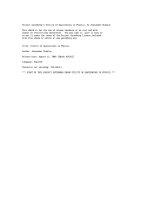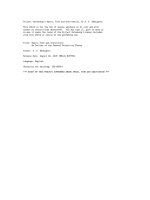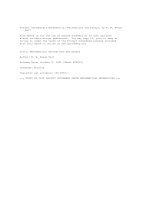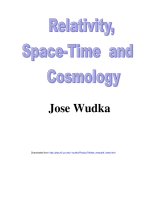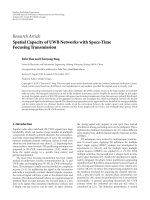- Trang chủ >>
- Khoa Học Tự Nhiên >>
- Vật lý
Project Gutenberg’s Space, Time and Gravitation pot
Bạn đang xem bản rút gọn của tài liệu. Xem và tải ngay bản đầy đủ của tài liệu tại đây (1.08 MB, 219 trang )
Project Gutenberg’s Space, Time and Gravitation, by A. S. Eddington
This eBook is for the use of anyone anywhere at no cost and with
almost no restrictions whatsoever. You may copy it, give it away or
re-use it under the terms of the Project Gutenberg License included
with this eBook or online at www.gutenberg.org
Title: Space, Time and Gravitation
An Outline of the General Relativity Theory
Author: A. S. Eddington
Release Date: August 24, 2009 [EBook #29782]
Language: English
Character set encoding: ISO-8859-1
*** START OF THIS PROJECT GUTENBERG EBOOK SPACE, TIME AND GRAVITATION ***
Produced by David Clarke, Andrew D. Hwang and the Online
Distributed Proofreading Team at (This
file was produced from images generously made available
by The Internet Archive/American Libraries.)
transcriber’s note
Figures may have been moved with respect to the surrounding
text. Minor typographical corrections and presentational changes
have been made without comment.
This PDF file is formatted for printing, but may be easily
formatted for screen viewing. Please see the preamble of the L
A
T
E
X
source file for instructions.
SPACE TIME
AND
GRAVITATION
CAMBRIDGE UNIVERSITY PRESS
C. F. CLAY, Manager
LONDON : FETTER LANE, E.C. 4
NEW YORK : THE MACMILLAN CO.
BOMBAY
CALCUTTA
MACMILLAN AND CO., Ltd.
MADRAS
TORONTO : THE MACMILLAN CO. OF
CANADA, Ltd.
TOKYO : MARUZEN-KABUSHIKI-KAISHA
ALL RIGHTS RESERVED
C. Davidson Frontispiece See page 107
eclipse instruments at sobral
SPACE TIME
AND
GRAVITATION
AN OUTLINE OF THE GENERAL
RELATIVITY THEORY
BY
A. S. EDDINGTON, M.A., M.Sc., F.R.S.
PLUMIAN PROFESSOR OF ASTRONOMY AND EXPERIMENTAL
PHILOSOPHY, CAMBRIDGE
CAMBRIDGE
AT THE UNIVERSITY PRESS
1920
Perhaps to move
His laughter at their quaint opinions wide
Hereafter, when they come to model heaven
And calculate the stars: how they will wield
The mighty frame: how build, unbuild, contrive
To save appearances.
Paradise Lost.
PREFACE
By his theory of relativity Albert Einstein has provoked a revolution of
thought in physical science.
The achievement consists essentially in this:—Einstein has succeeded in
separating far more completely than hitherto the share of the observer and
the share of external nature in the things we see happen. The perception
of an object by an observer depends on his own situation and circum-
stances; for example, distance will make it appear smaller and dimmer.
We make allowance for this almost unconsciously in interpreting what we
see. But it now appears that the allowance made for the motion of the ob-
server has hitherto been too crude—a fact overlooked because in practice
all observers share nearly the same motion, that of the earth. Physical
space and time are found to be closely bound up with this motion of the
observer; and only an amorphous combination of the two is left inher-
ent in the external world. When space and time are relegated to their
proper source—the observer—the world of nature which remains appears
strangely unfamiliar; but it is in reality simplified, and the underlying
unity of the principal phenomena is now clearly revealed. The deductions
from this new outlook have, with one doubtful exception, been confirmed
when tested by experiment.
It is my aim to give an account of this work without introducing any-
thing very technical in the way of mathematics, physics, or philosophy.
The new view of space and time, so opposed to our habits of thought,
must in any case demand unusual mental exercise. The results appear
strange; and the incongruity is not without a humorous side. For the first
nine chapters the task is one of interpreting a clear-cut theory, accepted
in all its essentials by a large and growing school of physicists—although
perhaps not everyone would accept the author’s views of its meaning.
Chapters x and xi deal with very recent advances, with regard to which
opinion is more fluid. As for the last chapter, containing the author’s
speculations on the meaning of nature, since it touches on the rudiments
of a philosophical system, it is perhaps too sanguine to hope that it can
viii PREFACE
ever be other than controversial.
A non-mathematical presentation has necessary limitations; and the
reader who wishes to learn how certain exact results follow from Einstein’s,
or even Newton’s, law of gravitation is bound to seek the reasons in a
mathematical treatise. But this limitation of range is perhaps less serious
than the limitation of intrinsic truth. There is a relativity of truth, as
there is a relativity of space.—
“For is and is-not though with Rule and Line
And up-and-down without, I could define.”
Alas! It is not so simple. We abstract from the phenomena that which is
peculiar to the position and motion of the observer; but can we abstract
that which is peculiar to the limited imagination of the human brain?
We think we can, but only in the symbolism of mathematics. As the
language of a poet rings with a truth that eludes the clumsy explanations
of his commentators, so the geometry of relativity in its perfect harmony
expresses a truth of form and type in nature, which my bowdlerised version
misses.
But the mind is not content to leave scientific Truth in a dry husk of
mathematical symbols, and demands that it shall be alloyed with famil-
iar images. The mathematician, who handles x so lightly, may fairly be
asked to state, not indeed the inscrutable meaning of x in nature, but the
meaning which x conveys to him.
Although primarily designed for readers without technical knowledge of
the subject, it is hoped that the book may also appeal to those who have
gone into the subject more deeply. A few notes have been added in the
Appendix mainly to bridge the gap between this and more mathematical
treatises, and to indicate the points of contact between the argument in
the text and the parallel analytical investigation.
It is impossible adequately to express my debt to contemporary lit-
erature and discussion. The writings of Einstein, Minkowski, Hilbert,
Lorentz, Weyl, Robb, and others, have provided the groundwork; in the
give and take of debate with friends and correspondents, the extensive
ramifications have gradually appeared.
A. S. E.
1 May, 1920.
CONTENTS
Eclipse Instruments at Sobral . . . . . . . . . . . . . . . Frontispiece
prologue page
What is Geometry? . . . . . . . . . . . . . . . . . . . . . . . 1
chapter i
The FitzGerald Contraction . . . . . . . . . . . . . . . . . 15
chapter ii
Relativity . . . . . . . . . . . . . . . . . . . . . . . . . . . . . 27
chapter iii
The World of Four Dimensions . . . . . . . . . . . . . . . . 41
chapter iv
Fields of Force . . . . . . . . . . . . . . . . . . . . . . . . . . 57
chapter v
Kinds of Space . . . . . . . . . . . . . . . . . . . . . . . . . . 69
chapter vi
The New Law of Gravitation and the Old Law . . . . . . 85
chapter vii
Weighing Light . . . . . . . . . . . . . . . . . . . . . . . . . . 101
chapter viii
Other Tests of the Theory . . . . . . . . . . . . . . . . . . 113
chapter ix
Momentum and Energy . . . . . . . . . . . . . . . . . . . . . 125
chapter x page
Towards Infinity . . . . . . . . . . . . . . . . . . . . . . . . . 141
chapter xi
Electricity and Gravitation . . . . . . . . . . . . . . . . . . 153
chapter xii
On the Nature of Things . . . . . . . . . . . . . . . . . . . . 165
appendix
Mathematical Notes . . . . . . . . . . . . . . . . . . . . . . . 183
Historical Note . . . . . . . . . . . . . . . . . . . . . . . . . 191
PROLOGUE
WHAT IS GEOMETRY?
A conversation between—
An experimental Physicist.
A pure Mathematician.
A Relativist, who advocates the newer conceptions of time and space
in physics.
Rel. There is a well-known proposition of Euclid which states that “Any
two sides of a triangle are together greater than the third side.” Can either
of you tell me whether nowadays there is good reason to believe that this
proposition is true?
Math. For my part, I am quite unable to say whether the proposition is
true or not. I can deduce it by trustworthy reasoning from certain other
propositions or axioms, which are supposed to be still more elementary. If
these axioms are true, the proposition is true; if the axioms are not true,
the proposition is not true universally. Whether the axioms are true or
not I cannot say, and it is outside my province to consider.
Phys. But is it not claimed that the truth of these axioms is self-evident?
Math. They are by no means self-evident to me; and I think the claim
has been generally abandoned.
Phys. Yet since on these axioms you have been able to found a logical
and self-consistent system of geometry, is not this indirect evidence that
they are true?
Math. No. Euclid’s geometry is not the only self-consistent system of
geometry. By choosing a different set of axioms I can, for example, arrive
at Lobatchewsky’s geometry, in which many of the propositions of Euclid
are not in general true. From my point of view there is nothing to choose
between these different geometries.
Rel. How is it then that Euclid’s geometry is so much the most impor-
tant system?
2 PROLOGUE
Math. I am scarcely prepared to admit that it is the most important.
But for reasons which I do not profess to understand, my friend the Physi-
cist is more interested in Euclidean geometry than in any other, and is
continually setting us problems in it. Consequently we have tended to
give an undue share of attention to the Euclidean system. There have,
however, been great geometers like Riemann who have done something to
restore a proper perspective.
Rel. (to Physicist). Why are you specially interested in Euclidean
geometry? Do you believe it to be the true geometry?
Phys. Yes. Our experimental work proves it true.
Rel. How, for example, do you prove that any two sides of a triangle
are together greater than the third side?
Phys. I can, of course, only prove it by taking a very large number of
typical cases, and I am limited by the inevitable inaccuracies of exper-
iment. My proofs are not so general or so perfect as those of the pure
mathematician. But it is a recognised principle in physical science that it
is permissible to generalise from a reasonably wide range of experiment;
and this kind of proof satisfies me.
Rel. It will satisfy me also. I need only trouble you with a special case.
Here is a triangle ABC; how will you prove that AB + BC is greater
than AC?
Phys. I shall take a scale and measure the three sides.
Rel. But we seem to be talking about different things. I was speaking
of a proposition of geometry—properties of space, not of matter. Your
experimental proof only shows how a material scale behaves when you
turn it into different positions.
Phys. I might arrange to make the measures with an optical device.
Rel. That is worse and worse. Now you are speaking of properties of
light.
Phys. I really cannot tell you anything about it, if you will not let
me make measurements of any kind. Measurement is my only means of
finding out about nature. I am not a metaphysicist.
Rel. Let us then agree that by length and distance you always mean
a quantity arrived at by measurements with material or optical appli-
ances. You have studied experimentally the laws obeyed by these mea-
sured lengths, and have found the geometry to which they conform. We
will call this geometry “Natural Geometry”; and it evidently has much
greater importance for you than any other of the systems which the brain
of the mathematician has invented. But we must remember that its sub-
ject matter involves the behaviour of material scales—the properties of
WHAT IS GEOMETRY? 3
matter. Its laws are just as much laws of physics as, for example, the laws
of electromagnetism.
Phys. Do you mean to compare space to a kind of magnetic field? I
scarcely understand.
Rel. You say that you cannot explore the world without some kind of
apparatus. If you explore with a scale, you find out the natural geometry;
if you explore with a magnetic needle, you find out the magnetic field.
What we may call the field of extension, or space-field, is just as much
a physical quality as the magnetic field. You can think of them both
existing together in the aether, if you like. The laws of both must be
determined by experiment. Of course, certain approximate laws of the
space-field (Euclidean geometry) have been familiar to us from childhood;
but we must get rid of the idea that there is anything inevitable about
these laws, and that it would be impossible to find in other parts of the
universe space-fields where these laws do not apply. As to how far space
really resembles a magnetic field, I do not wish to dogmatise; my point is
that they present themselves to experimental investigation in very much
the same way.
Let us proceed to examine the laws of natural geometry. I have a tape-
measure, and here is the triangle. AB = 39
1
2
in., BC =
1
8
in., CA = 39
7
8
in.
Why, your proposition does not hold!
Phys. You know very well what is wrong. You gave the tape-measure a
big stretch when you measured AB.
Rel. Why shouldn’t I?
Phys. Of course, a length must be measured with a rigid scale.
Rel. That is an important addition to our definition of length. But
what is a rigid scale?
Phys. A scale which always keeps the same length.
Rel. But we have just defined length as the quantity arrived at by
measures with a rigid scale; so you will want another rigid scale to test
whether the first one changes length; and a third to test the second; and
so ad infinitum. You remind me of the incident of the clock and time-gun
in Egypt. The man in charge of the time-gun fired it by the clock; and the
man in charge of the clock set it right by the time-gun. No, you must not
define length by means of a rigid scale, and define a rigid scale by means
of length.
Phys. I admit I am hazy about strict definitions. There is not time for
everything; and there are so many interesting things to find out in physics,
which take up my attention. Are you so sure that you are prepared with
a logical definition of all the terms you use?
4 PROLOGUE
Rel. Heaven forbid! I am not naturally inclined to be rigorous about
these things. Although I appreciate the value of the work of those who
are digging at the foundations of science, my own interests are mainly in
the upper structure. But sometimes, if we wish to add another storey, it
is necessary to deepen the foundations. I have a definite object in trying
to arrive at the exact meaning of length. A strange theory is floating
round, to which you may feel initial objections; and you probably would
not wish to let your views go by default. And after all, when you claim
to determine lengths to eight significant figures, you must have a pretty
definite standard of right and wrong measurements.
Phys. It is difficult to define what we mean by rigid; but in practice
we can tell if a scale is likely to change length appreciably in different
circumstances.
Rel. No. Do not bring in the idea of change of length in describing the
apparatus for defining length. Obviously the adopted standard of length
cannot change length, whatever it is made of. If a metre is defined as the
length of a certain bar, that bar can never be anything but a metre long;
and if we assert that this bar changes length, it is clear that we must have
changed our minds as to the definition of length. You recognised that my
tape-measure was a defective standard—that it was not rigid. That was
not because it changed length, because, if it was the standard of length,
it could not change length. It was lacking in some other quality.
You know an approximately rigid scale when you see one. What you
are comparing it with is not some non-measurable ideal of length, but
some attainable, or at least approachable, ideal of material constitution.
Ordinary scales have defects—flexure, expansion with temperature, etc.—
which can be reduced by suitable precautions; and the limit, to which you
approach as you reduce them, is your rigid scale. You can define these
defects without appealing to any extraneous definition of length; for ex-
ample, if you have two rods of the same material whose extremities are
just in contact with one another, and when one of them is heated the
extremities no longer can be adjusted to coincide, then the material has a
temperature-coefficient of expansion. Thus you can compare experimen-
tally the temperature-coefficients of different metals and arrange them in
diminishing sequence. In this sort of way you can specify the nature of
your ideal rigid rod, before you introduce the term length.
Phys. No doubt that is the way it should be defined.
Rel. We must recognise then that all our knowledge of space rests on the
behaviour of material measuring-scales free from certain definable defects
of constitution.
WHAT IS GEOMETRY? 5
Phys. I am not sure that I agree. Surely there is a sense in which the
statement AB = 2CD is true or false, even if we had no conception of a
material measuring-rod. For instance, there is, so to speak, twice as much
paper between A and B, as between C and D.
Rel. Provided the paper is uniform. But then, what does uniformity of
the paper mean? That the amount in given length is constant. We come
back at once to the need of defining length.
If you say instead that the amount of “space” between A and B is twice
that between C and D, the same thing applies. You imagine the intervals
filled with uniform space; but the uniformity simply means that the same
amount of space corresponds to each inch of your rigid measuring-rod.
You have arbitrarily used your rod to divide space into so-called equal
lumps. It all comes back to the rigid rod.
I think you were right at first when you said that you could not find out
anything without measurement; and measurement involves some specified
material appliance.
Now you admit that your measures cannot go beyond a certain close
approximation, and that you have not tried all possible conditions. Sup-
posing that one corner of your triangle was in a very intense gravita-
tional field—far stronger than any we have had experience of—I have
good ground for believing that under those conditions you might find the
sum of two sides of a triangle, as measured with a rigid rod, appreciably
less than the third side. In that case would you be prepared to give up
Euclidean geometry?
Phys. I think it would be risky to assume that the strong force of
gravitation made no difference to the experiment.
Rel. On my supposition it makes an important difference.
Phys. I mean that we might have to make corrections to the measures,
because the action of the strong force might possibly distort the measuring-
rod.
Rel. In a rigid rod we have eliminated any special response to strain.
Phys. But this is rather different. The extension of the rod is determined
by the positions taken up by the molecules under the forces to which they
are subjected; and there might be a response to the gravitational force
which all kinds of matter would share. This could scarcely be regarded as
a defect; and our so-called rigid rod would not be free from it any more
than any other kind of matter.
Rel. True; but what do you expect to obtain by correcting the measures?
You correct measures, when they are untrue to standard. Thus you correct
the readings of a hydrogen-thermometer to obtain the readings of a perfect
6 PROLOGUE
gas-thermometer, because the hydrogen molecules have finite size, and
exert special attractions on one another, and you prefer to take as standard
an ideal gas with infinitely small molecules. But in the present case, what
is the standard you are aiming at when you propose to correct measures
made with the rigid rod?
Phys. I see the difficulty. I have no knowledge of space apart from
my measures, and I have no better standard than the rigid rod. So it is
difficult to see what the corrected measures would mean. And yet it would
seem to me more natural to suppose that the failure of the proposition
was due to the measures going wrong rather than to an alteration in the
character of space.
Rel. Is not that because you are still a bit of a metaphysicist? You
keep some notion of a space which is superior to measurement, and are
ready to throw over the measures rather than let this space be distorted.
Even if there were reason for believing in such a space, what possible
reason could there be for assuming it to be Euclidean? Your sole reason
for believing space to be Euclidean is that hitherto your measures have
made it appear so; if now measures of certain parts of space prefer non-
Euclidean geometry, all reason for assuming Euclidean space disappears.
Mathematically and conceptually Euclidean and non-Euclidean space are
on the same footing; our preference for Euclidean space was based on
measures, and must stand or fall by measures.
Phys. Let me put it this way. I believe that I am trying to measure
something called length, which has an absolute meaning in nature, and is
of importance in connection with the laws of nature. This length obeys
Euclidean geometry. I believe my measures with a rigid rod determine
it accurately when no disturbance like gravitation is present; but in a
gravitational field it is not unreasonable to expect that the uncorrected
measures may not give it exactly.
Rel. You have three hypotheses there:—(1) there is an absolute thing
in nature corresponding to length, (2) the geometry of these absolute
lengths is Euclidean, and (3) practical measures determine this length
accurately when there is no gravitational force. I see no necessity for these
hypotheses, and propose to do without them. Hypotheses non fingo. The
second hypothesis seems to me particularly objectionable. You assume
that this absolute thing in nature obeys the laws of Euclidean geometry.
Surely it is contrary to scientific principles to lay down arbitrary laws for
nature to obey; we must find out her laws by experiment. In this case the
only experimental evidence is that measured lengths (which by your own
admission are not necessarily the same as this absolute thing) sometimes
WHAT IS GEOMETRY? 7
obey Euclidean geometry and sometimes do not. Again it would seem
reasonable to doubt your third hypothesis beyond, say, the sixth decimal
place; and that would play havoc with your more delicate measures. But
where I fundamentally differ from you is the first hypothesis. Is there some
absolute quantity in nature that we try to determine when we measure
length? When we try to determine the number of molecules in a given piece
of matter, we have to use indirect methods, and different methods may give
systematically different results; but no one doubts that there is a definite
number of molecules, so that there is some meaning in saying that certain
methods are theoretically good and others inaccurate. Counting appears
to be an absolute operation. But it seems to me that other physical
measures are on a different footing. Any physical quantity, such as length,
mass, force, etc., which is not a pure number, can only be defined as
the result arrived at by conducting a physical experiment according to
specified rules.
So I cannot conceive of any “length” in nature independent of a defini-
tion of the way of measuring length. And, if there is, we may disregard
it in physics, because it is beyond the range of experiment. Of course,
it is always possible that we may come across some quantity, not given
directly by experiment, which plays a fundamental part in theory. If so,
it will turn up in due course in our theoretical formulae. But it is no good
assuming such a quantity, and laying down a priori laws for it to obey, on
the off-chance of its proving useful.
Phys. Then you will not let me blame the measuring-rod when the
proposition fails?
Rel. By all means put the responsibility on the measuring-rod. Natural
geometry is the theory of the behaviour of material scales. Any proposition
in natural geometry is an assertion as to the behaviour of rigid scales,
which must accordingly take the blame or credit. But do not say that the
rigid scale is wrong, because that implies a standard of right which does
not exist.
Phys. The space which you are speaking of must be a sort of abstraction
of the extensional relations of matter.
Rel. Exactly so. And when I ask you to believe that space can be non-
Euclidean, or, in popular phrase, warped, I am not asking you for any
violent effort of the imagination; I only mean that the extensional rela-
tions of matter obey somewhat modified laws. Whenever we investigate
the properties of space experimentally, it is these extensional relations
that we are finding. Therefore it seems logical to conclude that space as
known to us must be the abstraction of these material relations, and not
8 PROLOGUE
something more transcendental. The reformed methods of teaching geom-
etry in schools would be utterly condemned, and it would be misleading
to set schoolboys to verify propositions of geometry by measurement, if
the space they are supposed to be studying had not this meaning.
I suspect that you are doubtful whether this abstraction of extensional
relations quite fulfils your general idea of space; and, as a necessity of
thought, you require something beyond. I do not think I need disturb
that impression, provided you realise that it is not the properties of this
more transcendental thing we are speaking of when we describe geometry
as Euclidean or non-Euclidean.
Math. The view has been widely held that space is neither physical nor
metaphysical, but conventional. Here is a passage from Poincar´e’s Science
and Hypothesis, which describes this alternative idea of space:
“If Lobatchewsky’s geometry is true, the parallax of a very distant star
will be finite. If Riemann’s is true, it will be negative. These are the
results which seem within the reach of experiment, and it is hoped that
astronomical observations may enable us to decide between the two ge-
ometries. But what we call a straight line in astronomy is simply the path
of a ray of light. If, therefore, we were to discover negative parallaxes,
or to prove that all parallaxes are higher than a certain limit, we should
have a choice between two conclusions: we could give up Euclidean geom-
etry, or modify the laws of optics, and suppose that light is not rigorously
propagated in a straight line. It is needless to add that everyone would
look upon this solution as the more advantageous. Euclidean geometry,
therefore, has nothing to fear from fresh experiments.”
Rel. Poincar´e’s brilliant exposition is a great help in understanding the
problem now confronting us. He brings out the interdependence between
geometrical laws and physical laws, which we have to bear in mind con-
tinually. We can add on to one set of laws that which we subtract from
the other set. I admit that space is conventional—for that matter, the
meaning of every word in the language is conventional. Moreover, we
have actually arrived at the parting of the ways imagined by Poincar´e,
though the crucial experiment is not precisely the one he mentions. But
I deliberately adopt the alternative, which, he takes for granted, everyone
would consider less advantageous. I call the space thus chosen physical
space, and its geometry natural geometry, thus admitting that other con-
ventional meanings of space and geometry are possible. If it were only
a question of the meaning of space—a rather vague term—these other
possibilities might have some advantages. But the meaning assigned to
length and distance has to go along with the meaning assigned to space.
WHAT IS GEOMETRY? 9
Now these are quantities which the physicist has been accustomed to mea-
sure with great accuracy; and they enter fundamentally into the whole of
our experimental knowledge of the world. We have a knowledge of the
so-called extent of the stellar universe, which, whatever it may amount
to in terms of ultimate reality, is not a mere description of location in a
conventional and arbitrary mathematical space. Are we to be robbed of
the terms in which we are accustomed to describe that knowledge?
The law of Boyle states that the pressure of a gas is proportional to
its density. It is found by experiment that this law is only approximately
true. A certain mathematical simplicity would be gained by conventionally
redefining pressure in such a way that Boyle’s law would be rigorously
obeyed. But it would be high-handed to appropriate the word pressure in
this way, unless it had been ascertained that the physicist had no further
use for it in its original meaning.
Phys. I have one other objection. Apart from measures, we have a
general perception of space, and the space we perceive is at least approx-
imately Euclidean.
Rel. Our perceptions are crude measures. It is true that our perception
of space is very largely a matter of optical measures with the eyes. If in
a strong gravitational field optical and mechanical measures diverged, we
should have to make up our minds which was the preferable standard,
and afterwards abide by it. So far as we can ascertain, however, they
agree in all circumstances, and no such difficulty arises. So, if physical
measures give us a non-Euclidean space, the space of perception will be
non-Euclidean. If you were transplanted into an extremely intense gravi-
tational field, you would directly perceive the non-Euclidean properties of
space.
Phys. Non-Euclidean space seems contrary to reason.
Math. It is not contrary to reason, but contrary to common experience,
which is a very different thing, since experience is very limited.
Phys. I cannot imagine myself perceiving non-Euclidean space!
Math. Look at the reflection of the room in a polished doorknob, and
imagine yourself one of the actors in what you see going on there.
Rel. I have another point to raise. The distance between two points
is to be the length measured with a rigid scale. Let us mark the two
points by particles of matter, because we must somehow identify them
by reference to material objects. For simplicity we shall suppose that the
two particles have no relative motion, so that the distance—whatever it
is—remains constant. Now you will probably agree that there is no such
thing as absolute motion; consequently there is no standard condition of
10 PROLOGUE
the scale which we can call “at rest.” We may measure with the scale
moving in any way we choose, and if results for different motions disagree,
there is no criterion for selecting the true one. Further, if the particles are
sliding past the scale, it makes all the difference what instants we choose
for making the two readings.
Phys. You can avoid that by defining distance as the measurement made
with a scale which has the same velocity as the two points. Then they
will always be in contact with two particular divisions of the scale.
Rel. A very sound definition; but unfortunately it does not agree with
the meaning of distance in general use. When the relativist wishes to refer
to this length, he calls it the proper-length; in non-relativity physics it does
not seem to have been used at all. You see it is not convenient to send
your apparatus hurling through the laboratory—after a pair of α particles,
for example. And you could scarcely measure the length of a wave of light
by this convention
∗
. So the physicist refers his lengths to apparatus at
rest on the earth; and the mathematician starts with the words “Choose
unaccelerated rectangular axes Ox, Oy, Oz, . . . ” and assumes that the
measuring-scales are at rest relatively to these axes. So when the term
length is used some arbitrary standard motion of the measuring apparatus
must always be implied.
Phys. Then if you have fixed your standard motion of the measuring-
rod, there will be no ambiguity if you take the readings of both particles
at the same moment.
Rel. What is the same moment at different places? The conception
of simultaneity in different places is a difficult one. Is there a particular
instant in the progress of time on another world, Arcturus, which is the
same as the present instant on the Earth?
Phys. I think so, if there is any connecting link. We can observe an
event, say a change of brightness, on Arcturus, and, allowing for the time
taken by light to travel the distance, determine the corresponding instant
on the earth.
Rel. But then you must know the speed of the earth through the aether.
It may have shortened the light-time by going some way to meet the light
coming from Arcturus.
Phys. Is not that a small matter?
Rel. At a very modest reckoning the motion of the earth in the interval
might alter the light-time by several days. Actually, however, any speed of
the earth through the aether up to the velocity of light is admissible, with-
∗
The proper-length of a light-wave is actually infinite.
WHAT IS GEOMETRY? 11
out affecting anything observable. At least, nothing has been discovered
which contradicts this. So the error may be months or years.
Phys. What you have shown is that we have not sufficient knowledge
to determine in practice which are simultaneous events on the Earth and
Arcturus. It does not follow that there is no definite simultaneity.
Rel. That is true, but it is at least possible that the reason why we are
unable to determine simultaneity in practice (or, what comes to pretty
much the same thing, our motion through the aether) in spite of many
brilliant attempts, is that there is no such thing as absolute simultaneity
of distant events. It is better therefore not to base our physics on this
notion of absolute simultaneity, which may turn out not to exist, and is
in any case out of reach at present.
But what all this comes to is that time as well as space is implied
in all our measures. The fundamental measurement is not the interval
between two points of space, but between two points of space associated
with instants of time.
Our natural geometry is incomplete at present. We must supplement it
by bringing in time as well as space. We shall need a perfect clock as well
as a rigid scale for our measures. It may be difficult to choose an ideal
standard clock; but whatever definition we decide on must be a physical
definition. We must not dodge it by saying that a perfect clock is one
which keeps perfect time. Perhaps the best theoretical clock would be a
pulse of light travelling in vacuum to and fro between mirrors at the ends
of a rigid scale. The instants of arrival at one end would define equal
intervals of time.
Phys. I think your unit of time would change according to the motion
of your “clock” through the aether.
Rel. Then you are comparing it with some notion of absolute time. I
have no notion of time except as the result of measurement with some kind
of clock. (Our immediate perception of the flight of time is presumably
associated with molecular processes in the brain which play the part of a
material clock.) If you know a better clock, let us adopt it; but, having
once fixed on our ideal clock there can be no appeal from its judgments.
You must remember too that if you wish to measure a second at one place,
you must keep your clock fixed at what you consider to be one place; so
its motion is defined. The necessity of defining the motion of the clock
emphasises that one cannot consider time apart from space; there is one
geometry comprising both.
Phys. Is it right to call this study geometry? Geometry deals with space
alone.
12 PROLOGUE
Math. I have no objection. It is only necessary to consider time as a
fourth dimension. Your complete natural geometry will be a geometry of
four dimensions.
Phys. Have we then found the long-sought fourth dimension?
Math. It depends what kind of a fourth dimension you were seeking.
Probably not in the sense you intend. For me it only means adding a fourth
variable, t, to my three space-variables x, y, z. It is no concern of mine
what these variables really represent. You give me a few fundamental laws
that they satisfy, and I proceed to deduce other consequences that may be
of interest to you. The four variables may for all I know be the pressure,
density, temperature and entropy of a gas; that is of no importance to
me. But you would not say that a gas had four dimensions because four
mathematical variables were used to describe it. Your use of the term
“dimensions” is probably more restricted than mine.
Phys. I know that it is often a help to represent pressure and volume
as height and width on paper; and so geometry may have applications to
the theory of gases. But is it not going rather far to say that geometry
can deal directly with these things and is not necessarily concerned with
lengths in space?
Math. No. Geometry is nowadays largely analytical, so that in form as
well as in effect, it deals with variables of an unknown nature. It is true
that I can often see results more easily by taking my x and y as lengths
on a sheet of paper. Perhaps it would be helpful in seeing other results if I
took them as pressure and density in a steam-engine; but a steam-engine
is not so handy as a pencil. It is literally true that I do not want to know
the significance of the variables x, y, z, t that I am discussing. That is
lucky for the Relativist, because although he has defined carefully how
they are to be measured, he has certainly not conveyed to me any notion
of how I am to picture them, if my picture of absolute space is an illusion.
Phys. Yours is a strange subject. You told us at the beginning that you
are not concerned as to whether your propositions are true, and now you
tell us you do not even care to know what you are talking about.
Math. That is an excellent description of Pure Mathematics, which has
already been given by an eminent mathematician
∗
.
∗
“Pure mathematics consists entirely of such asseverations as that, if such and
such a proposition is true of anything, then such and such a proposition is true of
that thing. It is essential not to discuss whether the first proposition is really true,
and not to mention what the anything is of which it is supposed to be true. . . . Thus
mathematics may be defined as the subject in which we never know what we are talking
about, nor whether what we are saying is true.”
Bertrand Russell.
WHAT IS GEOMETRY? 13
Rel. I think there is a real sense in which time is a fourth dimension—as
distinct from a fourth variable. The term dimension seems to be associated
with relations of order. I believe that the order of events in nature is one
indissoluble four-dimensional order. We may split it arbitrarily into space
and time, just as we can split the order of space into length, breadth and
thickness. But space without time is as incomplete as a surface without
thickness.
Math. Do you argue that the real world behind the phenomena is four-
dimensional?
Rel. I think that in the real world there must be a set of entities related
to one another in a four-dimensional order, and that these are the basis
of the perceptual world so far as it is yet explored by physics. But it is
possible to pick out a four-dimensional set of entities from a basal world of
five dimensions, or even of three dimensions. The straight lines in three-
dimensional space form a four-dimensional set of entities, i.e. they have a
four-fold order. So one cannot predict the ultimate number of dimensions
in the world—if indeed the expression dimensions is applicable.
Phys. What would a philosopher think of these conceptions? Or is he
solely concerned with a metaphysical space and time which is not within
reach of measurement.
Rel. In so far as he is a psychologist our results must concern him. Per-
ception is a kind of crude physical measurement; and perceptual space and
time is the same as the measured space and time, which is the subject-
matter of natural geometry. In other respects he may not be so immedi-
ately concerned. Physicists and philosophers have long agreed that motion
through absolute space can have no meaning; but in physics the question
is whether motion through aether has any meaning. I consider that it has
no meaning; but that answer, though it brings philosophy and physics into
closer relation, has no bearing on the philosophic question of absolute mo-
tion. I think, however, we are entitled to expect a benevolent interest from
philosophers, in that we are giving to their ideas a perhaps unexpected
practical application.
Let me now try to sum up my conclusions from this conversation. We
have been trying to give a precise meaning to the term space, so that we
may be able to determine exactly the properties of the space we live in.
There is no means of determining the properties of our space by a priori
reasoning, because there are many possible kinds of space to choose from,
no one of which can be considered more likely than any other. For more
than 2000 years we have believed in a Euclidean space, because certain
experiments favoured it; but there is now reason to believe that these same
